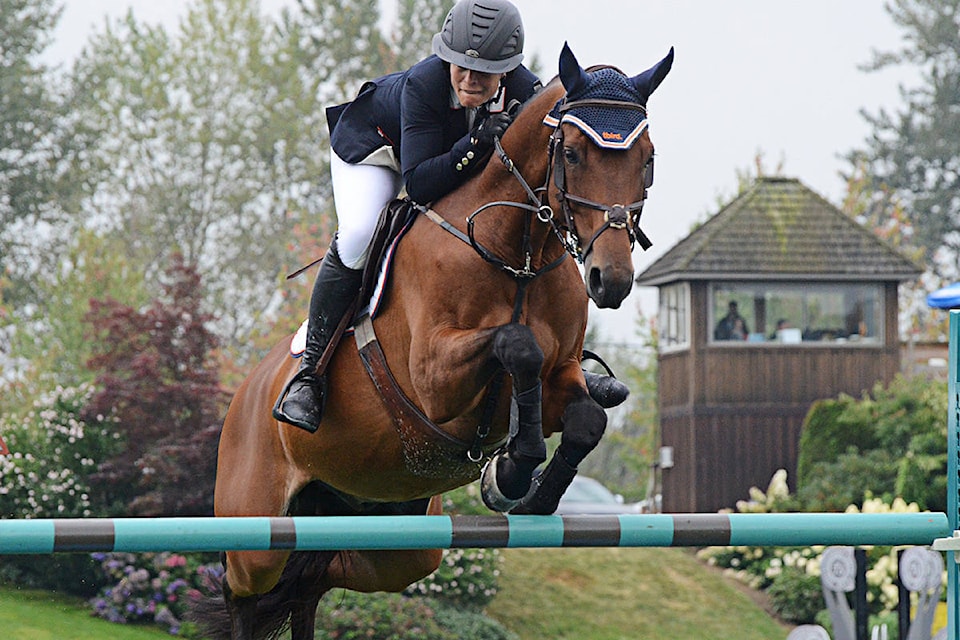Ronda Payne/Special to the Langley Advance Times
In some sports, like hockey or basketball, it’s easy to know the score and how competitors are doing.
There’s often no need for a scoreboard to understand exactly what happened and when.
Horse jumping is a more subtle sport when it comes to understanding scores, but with the right information, spectators can soon know exactly how their favourite horse and rider made out without dependence upon the score board.
At the Sunday, June 2 Longines FEI Jumping Nations Cup of Canada presented by Odlum Brown BC Open at Thunderbird Show Park, a wide range of high-calibre horses and riders will be competing for healthy amounts of prize money.
With high stakes come fast and complex courses where only the best riders and horses will succeed.
Nations Cup events are like team sports, in that it is a collaborative effort by a team’s four riders and horses to achieve the best score. However, each horse and rider also competes individually.
It can be both exhilarating and heart-breaking to watch equestrian sport. What happens if a hoof hits a rail? What if a horse and rider have a poor round? And what if a horse refuses to jump?
The most important thing to know is that the team of four riders and horses with the combined lowest number of faults will win.
There are two rounds of competition.
In the first round, the team coach decides the order. In the second round, the order is decided by the faults accumulated by the team.
Once both rounds are complete, the best three scores (the score with the most faults is eliminated) of each team’s riders will be combined and compared to other teams.
The team with the lowest score over the two rounds wins.
Here’s a simple guide to help explain some basics of the horse jumping scoring system and vocabulary as they apply to Nations Cup events.
.
Jumping terminology
Equestrian and show jumping, like many sports, have their own set of terms. While it’s not essential to know the words to appreciate it, it can help:
• Every rider hopes for a clean round which is when the horse completes the course within the time allowed and has no faults or refusals.
• Riders who achieve a clean round likely have the best takeoff – the optimal point where the horse must be starting the jump in order to clear the obstacle.
• If a horse stops or runs to the side of an obstacle, this is called a refusal. The first refusal adds four faults. A second refusal results in elimination from the round, but if this second refusal happens in the first round at a Nations Cup, the horse and rider will still return for the second round.
• The order of the competitors plays a part in how horses and riders perform. This is known as Order of Go and is a random order based on a draw. It’s always best to be drawn last in the order.
.
Faults, knockdowns & jumps
• Four faults are assigned to a horse and rider team when they have a knockdown – when the horse and rider have knocked down the top part of a jump and it lowers the height of an obstacle.
• At water jumps, four faults are incurred if the horse’s hoof touches the water or the taped boundary marking.
• Time faults are allotted at one fault for every four seconds over the time allowed.
• There is a four-fault maximum for any jump, so whether the top bar jiggles slightly before dropping to the ground or all the rails for the whole obstacle go flying, it’s the same number of faults.
• Hitting or brushing a rail, but not knocking it down, does not result in a fault.
• A rail in the middle of the obstacle can fall and will not result in a fault. Faults are assigned only if the height of the jump is reduced.
.
Jump types
Types of jumps include the vertical gate, which is quite easy to knock down; the vertical wall, which is challenging because of its solid structure the horse can’t see through; the oxer, which is a pair of jumps with a gap in between forcing the horse to jump both high and long, the triple bar, which is three jumps with space in between and rails starting low at the takoff point and high at the other side; the water jump includes a low obstacle before a 10 to 16 foot stretch of water and; the combination, which is a series of jumps, one or two strides apart, that is dependent upon clearing each jump correctly to set up for the next jump.
Riders are permitted to walk the course prior to jumping, in order to better understand the angles of approach and lines they need to take.
A clean round is every horse and rider’s goal, so spectators will always be cheering when a team completes a round of the course without knocking down rails and does so under the allotted time.
.
RELATED STORIES:
Canadian versus U.S. battle unfolding in Langley is heating up
VIDEO: Langley Grand Prix gala sets a record for contributions
Grandstand seating adds to tbird experience in Langley
Canine and equine both compete at Langley show park
.
_________________________________
Is there more to this story?
Email: news@langleyadvancetimes.com
Like us on Facebook or follow us on Twitter
_________________________________
